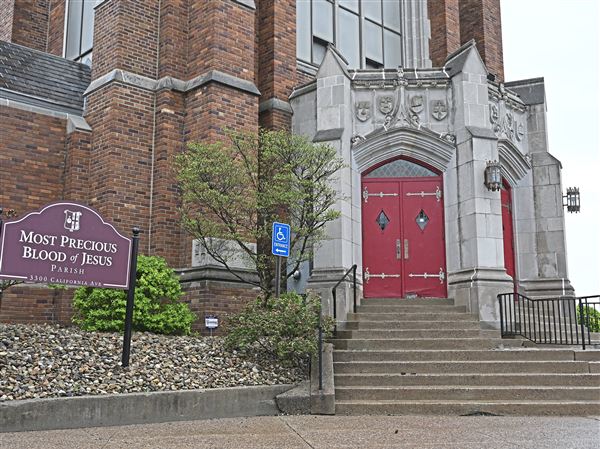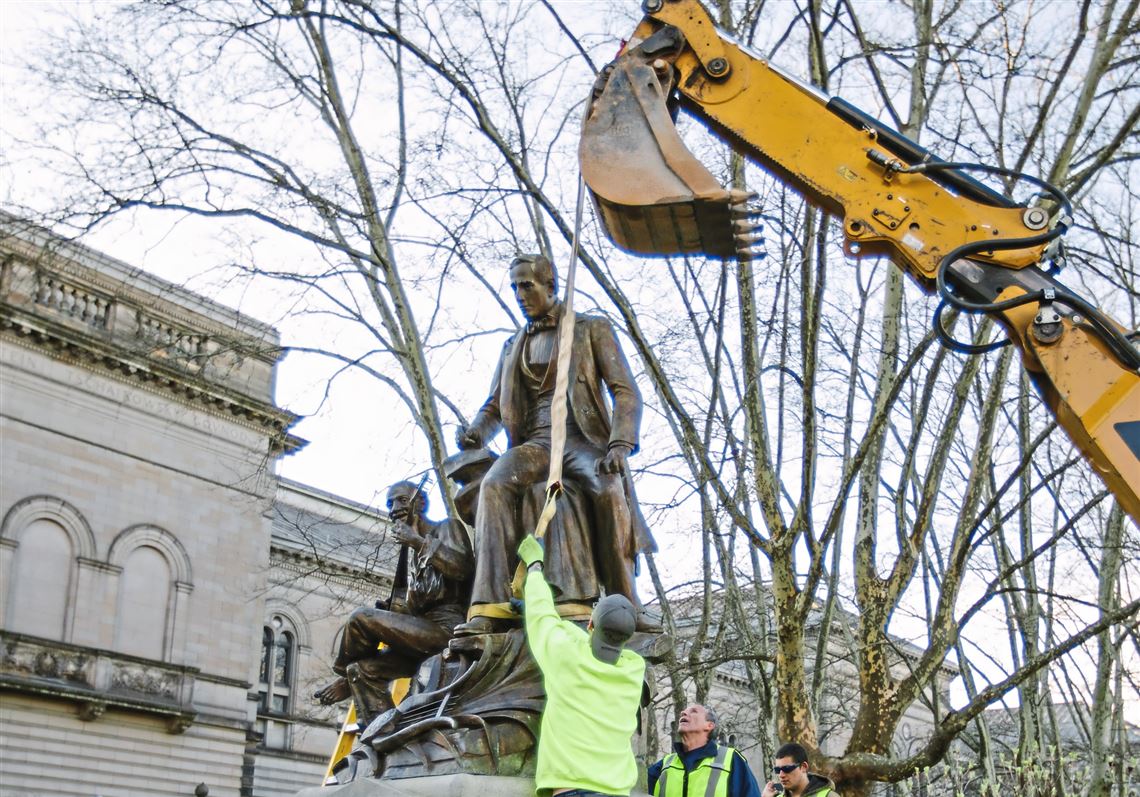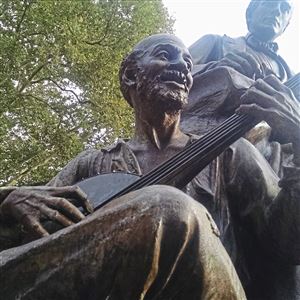In the end, the contentious old statue at Schenley Plaza didn’t put up any fight.
Fasteners that once tied the bronze piece to a granite base had rotted long ago. When city workers showed up about dawn Thursday, it took them less than an hour to hoist, lower and then secure the Stephen Foster sculpture in a flatbed truck bound for storage.
“The only thing that was unexpected [was] that it went smoother than I was hoping,” said Tom Samstag, acting construction supervisor in the city Department of Public Works.
Workers estimated the city-owned statue weighs 800 pounds and its base more than six tons, Mr. Samstag said. Drivers hauled them both from Oakland to a city facility in Highland Park, shielded from public view while Mayor Bill Peduto’s administration tries to find the century-old artwork a permanent spot.
The move followed an October decision by the Pittsburgh Art Commission, which found that the statue should be removed within six months and hosted in a private, “properly contextualized” location. Many residents have held that the sculpture — showing a shoeless African-American banjo player seated at the famed composer’s feet — is condescending or outright racist. Speakers at commission meetings last year largely agreed.
“Obviously, it was popular and meaningful to the people of Pittsburgh back when it was placed” in 1900, Peduto spokesman Timothy McNulty said. Clearly, he said, time shifted the public’s view.
At least a couple of passers-by hollered — one against the removal, the other for it — as news crews and about 10 public-works employees gathered at the statue Thursday. A backhoe lifted the sculpture with ease, following a plan that was two to three months in the making.
The Peduto administration made clear last fall that it would honor the panel decision and pull the piece, although the general public wasn’t told precisely when. The city alerted reporters Wednesday but placed the information under an embargo, meaning it couldn’t be distributed until 7 a.m. the next day.
Mr. McNulty said he “just wanted to let the public-works guys do their job without too much interference because it’s a very sensitive job to them.” News media asked for an advisory before the removal, he said.
Earlier this week, Mr. Peduto said the city had reached out to more than a dozen organizations to find the Foster statue a new home. So far, none was able or interested enough to take it, he said. Discussions are continuing.
“We’ll find a location that’s appropriate. We’ll take the time to do it right,” Mr. Peduto said, noting the sculpture was moved in the 1940s from an initial perch in Highland Park. The administration wouldn’t say which groups recently declined to play host.
Still, Peduto chief of staff Dan Gilman said it’s important that the location be chosen through a public effort.
“For us, it’s more about the process than the final determination,” he said. While the city should recognize history, the statue should be situated where people can explore its background, intent and nuances in full context, including why it offends, Mr. Gilman said.
Foster, a Pittsburgh native, composed well-known songs including “Oh! Susannah” and “My Old Kentucky Home.” He died at age 37 in 1864.
In place of his statue, the Peduto administration wants to honor an African-American woman — or women — at the same site near Forbes Avenue. The idea builds on an October 2017 newspaper column by historian Jessie B. Ramey, who urged the recognition of women in public art.
She offered seven suggestions, including Gwendolyn J. Elliott, the Pittsburgh police bureau’s first black female commander; abolitionist Catherine Delany; and singer Mary Cardwell Dawson, who started the Cardwell School of Music in Homewood. The seven are among prospects for the new statue’s honoree or honorees.
“You have so many options that I think would be hard to choose [only] one,” said Kim Olday, 55, of Wilkinsburg. She joined about 20 others Wednesday at Nazarene Baptist Church in Homewood, which hosted the third of five community meetings on the plan.
Attendees said the new piece should foreshadow more recognition of African American women in Pittsburgh’s public art. No existing monuments in the city represent the demographic, according to the administration.
“It shouldn’t be a one-shot job. It shouldn’t be a one-shot wonder,” said Donna Alexander, 66, of Wilkinsburg, who is Ms. Olday’s sister. She urged community programs, perhaps a scavenger hunt, to help youngsters explore artistic works.
More conversations on the future statue are slated for 6:30 to 8:30 p.m. Tuesday at the Sheraden Healthy Active Living Center, 720 Sherwood Ave., and from 6:30 to 8:30 p.m. Thursday at the Hill House Association, 1835 Centre Ave., Hill District. Free registration is available at https://bit.ly/2GOR2jz.
Adam Smeltz: 412-263-2625, asmeltz@post-gazette.com, @asmeltz.
First Published: April 26, 2018, 11:01 a.m.
Updated: April 26, 2018, 11:07 a.m.



















